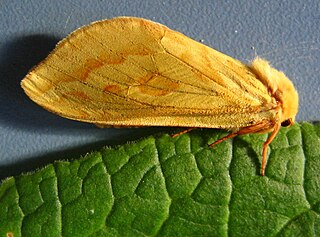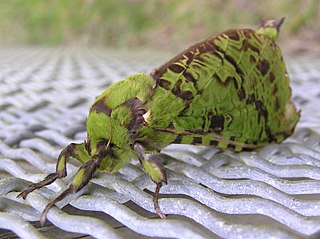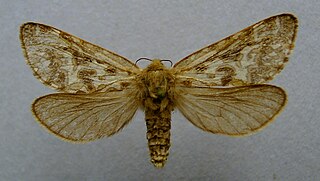
The Hepialidae are a family of insects in the lepidopteran order. Moths of this family are often referred to as swift moths or ghost moths.

The ghost moth or ghost swift is a moth of the family Hepialidae. It is common throughout Europe, except for the far south-east.

Abantiades is a genus of moths of the family Hepialidae. There are 37 described species, all found exclusively in Australia. The group includes some large species with a wingspan of up to 160 mm. The larvae feed on the roots of Eucalyptus and other trees. Simonsen's 2018 revision of the Australian Hepialidae synonymized the genera Bordaia and Trictena to Abantiades, and included the former genera's species here.

Aenetus is a genus of moths of the family Hepialidae. There are 24 described species found in Indonesia, New Guinea, New Caledonia, Australia and New Zealand. Most species have green or blue forewings and reddish hindwings, but some are predominantly brown or white. The larvae feed in the trunks of living trees, burrowing horizontally into the trunk, then vertically down.

The Hepialoidea are the superfamily of "ghost moths" and "swift moths".
Bipectilus is a genus of moths of the family Hepialidae. There are eight described species in the genus, distributed through China, Nepal and Vietnam.
Dalaca is a genus of moths of the family Hepialidae. There are 23 described species found throughout South America as far north as Panama. The larvae feed on grasses.

Endoclita is a genus of moths of the family Hepialidae. There are 60 described species found in eastern and southeast Asia and the Indian subcontinent.

Eudalaca is a genus of moths of the family Hepialidae. There are 35 described species, most restricted to South Africa but a few found further north in the continent.

Fraus is a genus of moths of the family Hepialidae. There are 25 described species, all endemic to Australia.

Pharmacis is a genus of moths of the family Hepialidae. There are eight described species found in Eurasia.

The gold swift is a moth belonging to the family Hepialidae. Until recently it was placed in the genus Hepialus. The species was first described by Carl Linnaeus in his 1758 10th edition of Systema Naturae. Moths of the Hepialidae are considered to be primitive moths; they do not have a proboscis and are unable to feed. The gold swift is a widespread species found in Europe and Asia, including Japan.

Abantiades latipennis, known as the Pindi moth, is a species of moth in the family Hepialidae. It may also be referred to as a swift moth or a ghost moth, as this is a common name associated with Hepialidae. Endemic to Australia and identified in 1932, it is most populous in temperate rainforest where eucalypti are prevalent, as the larvae feed primarily on the roots of these trees. Females lay eggs during flight in a scattering fashion. The larvae live for over eighteen months underground, while adult moths survive for approximately one week, as they have no mouthparts with which to feed. The moths are preyed upon by a number of predators, including bats and owls. Brown in colour overall, males are paler and the identifying silver bars of the male's wings are more prominent than those of the female's, with dark margins. Male adults are generally smaller.
Aplatissa michaelis is a species of moth of the family Hepialidae. It is endemic to Brazil.
Aplatissa strangoides is a species of moth of the family Hepialidae. It is endemic to Brazil.
Endoclita excrescens is a species of moth of the family Hepialidae. It is known from Japan and the Russian Far East. Food plants for this species include Castanea, Nicotiana, Paulownia, Quercus, and Raphanus. The species is considered a pest of the tobacco plant.

Sthenopis pretiosus, the gold-spotted ghost moth, is a species of moth of the family Hepialidae. It was first described by Gottlieb August Wilhelm Herrich-Schäffer in 1856. It can be found in found Brazil, Venezuela and in the eastern United States and south-eastern Canada.

Sthenopis purpurascens, the four-spotted ghost moth, is a species of moth of the family Hepialidae. It was described by Packard in 1863. It is found in Canada and the United States, from Labrador and New York north and west to British Columbia and the Northwest Territories, south in the mountains to Arizona.

Triodia amasinus is a species of moth belonging to the family Hepialidae. It was described by Gottlieb August Wilhelm Herrich-Schäffer in 1851, and it is known from Turkey, Hungary, Romania, Bulgaria, the Republic of Macedonia, Albania and Greece.
This page is based on this
Wikipedia article Text is available under the
CC BY-SA 4.0 license; additional terms may apply.
Images, videos and audio are available under their respective licenses.












